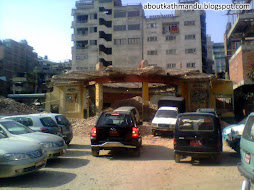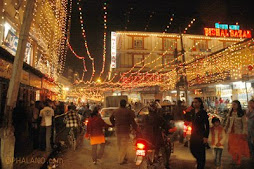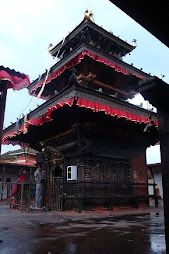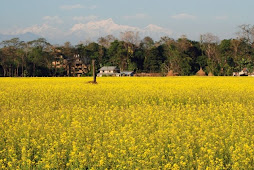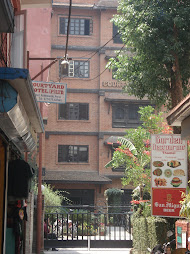Ok, let's go back to the river! The two rivers and their tributaries still flow through the Kathmandu Valley, but the flow is a deathly slow, the sights ghastly, and the sound silent. The birds that used to chirp on the branches of the trees that lined the riverbanks are long gone, replaced by the sounds of plastic shopping bags shuffling in the wind. Stray dogs try to snatch whatever they can find in the garbage that now has replaced the fine sand, which as a young boy I used to collect every year a few days before the arrival of Ghatasthapana (sometime in October), the first day of the ten-day worship of goddess Maha Durga. On this occasion, it had been my job (my grandfather had assigned it to me) every year to visit the Bishnumati river to hand-dig the finest sand I could find along the riverbanks, and bring home a bag full of sand. My grandfather would then make two rectangular rows (approx. 1x3 ft each) of sand inside the worship room specially made for this occasion, and sprinkle holy water and barley seeds. On the tenth day, the barley seeds would grow to about 6-7 inches tall, light green in color. The entire family would receive red tika (aacheta) and jamara from my grandfather, as part of the Dashain Tika celebrations.
More to come...
Saturday, June 27, 2009
Friday, June 26, 2009
Music is in the Air!
I feel sad today. The news of Michael Jackson's (MJ) death came as a complete surprise and shock to us. MJ was an exceptionally gifted singer and dancer. My friends and I were mesmerized by "Thriller" and especially by his "moonwalk" dance moves. The year was 1982. Videos had been introduced already in Kathmandu in 1980. But since TV/VCR equipment was very expensive, special arrangements had to be made to see videos. The first set of movies that I had seen on video was Amardeep (Rajesh Khanna - my favorite Bollywood actor), Suhaag (Amithab Bacchan), and a Chinese Kung-Fu comedy in 1980, all in one sitting. A friend's relative had rented the equipment for the day, we had to contribute 25 rupees each to see the movies. Watching the moives on a small box (the TV screen must have been 20 inches) felt very strange (Satellite reception had not arrived yet). The experienced seemed unreal and somewhat weird.
Masan Galli (behind Indrachowk) was the center for all viewing pleasures. Many residents of Masan Galli were the pioneering entrepreneurs in providing video viewing services (for a fee, of course). I used to go with my friends to watch Hollywood movies, as we felt they were different from the usual song and dance masalas of Bollywood movies. Another reason to watch English movies was to pick up some slangs and learn how to use them in everyday conversation. I was already used to wathcing English movies. When I was in Grade 7, our English teacher (she was an American) had taken our class to go see The Wizard of Oz, and Twenty Thousand Leagues Under the Sea at the British Embassy compound. Several cinema halls in Kathmandu, specially Jay Nepal Chitraghar, used to show English movies (I remember seeing movies like the Return of Ringo, Death is Quick, Diamonds for Ursula, Imperial Venice). With the arrival of videos in Kathmandu, we slowly started watching more English movies, and Masan Galli was naturally the place to be.
Video owners or their agents would come out on the streets and announce that such and such movie would be played at certain times. Public viewing at private residences was still not illegal, as it would be in later years. Once inside the house, we usually had to wait for 30 minutes until the room filled to its capacity, or, at least until the specified show time. To keep the viewers entertained while the owner waited for more customers, the audience were provided free previews of other movies or concerts. The "Thriller" music video was always on high demand. We would be almost in a hypnotic state, completely engrossed in MJ's "moonwalking" moves. Later on, back in our neighborhood my friends would try out MJ's moves and would argue who had the best imitations.
MJ had swept Kathmandu's music scene. Everywhere on the street audio cassettes would be playing "Beat It", "Billy Jean", and "Thriller" - the three were MJ's most commonly played songs on the streets. I did not have a cassette player, so I used to visit my friends to listen to these songs. We did not understand the lyrics, nor we cared to learn the words, all we cared for was the electrifying sound, the mesmerizing rhythm, and MJ's oohs and aahs! Of course, back then Bollywood movies had a total grip on most Nepali's musical interests, but many of us had also heard about the Beatles, Elvis, ABBA, Rod Stewart, Eagles, and the Bee Gees. However, none were as popular as MJ (at least during my days).
So, it was kind of sad to learn that MJ is no more. I wanted my kids to understand the gripping influence MJ had on yongsters like me. This afternoon, my two kids and I went to Bestbuy to look for "Thriller", but we did not find it. Luckily for us, we found one copy of "Michael Jackson Number Ones" on the shelf. We bought it and on our way home played it loud, enjoying it just as much as I had enjoyed it back then, and remembering the "King of Pop" and his extraordinary talent.
Masan Galli (behind Indrachowk) was the center for all viewing pleasures. Many residents of Masan Galli were the pioneering entrepreneurs in providing video viewing services (for a fee, of course). I used to go with my friends to watch Hollywood movies, as we felt they were different from the usual song and dance masalas of Bollywood movies. Another reason to watch English movies was to pick up some slangs and learn how to use them in everyday conversation. I was already used to wathcing English movies. When I was in Grade 7, our English teacher (she was an American) had taken our class to go see The Wizard of Oz, and Twenty Thousand Leagues Under the Sea at the British Embassy compound. Several cinema halls in Kathmandu, specially Jay Nepal Chitraghar, used to show English movies (I remember seeing movies like the Return of Ringo, Death is Quick, Diamonds for Ursula, Imperial Venice). With the arrival of videos in Kathmandu, we slowly started watching more English movies, and Masan Galli was naturally the place to be.
Video owners or their agents would come out on the streets and announce that such and such movie would be played at certain times. Public viewing at private residences was still not illegal, as it would be in later years. Once inside the house, we usually had to wait for 30 minutes until the room filled to its capacity, or, at least until the specified show time. To keep the viewers entertained while the owner waited for more customers, the audience were provided free previews of other movies or concerts. The "Thriller" music video was always on high demand. We would be almost in a hypnotic state, completely engrossed in MJ's "moonwalking" moves. Later on, back in our neighborhood my friends would try out MJ's moves and would argue who had the best imitations.
MJ had swept Kathmandu's music scene. Everywhere on the street audio cassettes would be playing "Beat It", "Billy Jean", and "Thriller" - the three were MJ's most commonly played songs on the streets. I did not have a cassette player, so I used to visit my friends to listen to these songs. We did not understand the lyrics, nor we cared to learn the words, all we cared for was the electrifying sound, the mesmerizing rhythm, and MJ's oohs and aahs! Of course, back then Bollywood movies had a total grip on most Nepali's musical interests, but many of us had also heard about the Beatles, Elvis, ABBA, Rod Stewart, Eagles, and the Bee Gees. However, none were as popular as MJ (at least during my days).
So, it was kind of sad to learn that MJ is no more. I wanted my kids to understand the gripping influence MJ had on yongsters like me. This afternoon, my two kids and I went to Bestbuy to look for "Thriller", but we did not find it. Luckily for us, we found one copy of "Michael Jackson Number Ones" on the shelf. We bought it and on our way home played it loud, enjoying it just as much as I had enjoyed it back then, and remembering the "King of Pop" and his extraordinary talent.
Thursday, June 25, 2009
How Green Was My Valley?
As I have briefly mentioned in my last posting, wandering around the riverbanks of Bishnumati meant lots of exposure to agricultural farms that the Jyapu had painstakingly worked. There were cucumbers, squash (farsi), beans of all varietes, spinach, carrots and rato mula (red radish not the round variety but similar to Daikon). The last two were the ones, which we occasionally liked to give oursleves a hand to. The carrots were sweet and tender while the radishes had a kind of tangy flavor. Sometimes the farmer would yell at us, and try to chase off his field. My friends and I would run scared, sometimes with a speed of a motorcycle, pretending the aali (bund) on the farmer's field to be our super-highway and the wind beneath our wings to be the gasoline that powered our engines. I remember a day returning from school, sometime late in the afternoon, walking amidst a farmer's field near the Bishumati bridge in Balaju. I came upon a round, green squash right in front of me. The squash was still attached to the plant. I was attracted by its size and its rich dark green color, as if the squash was inviting me to reach out and carry it away from the field. Of course, I could not carry it home, which was 20 minutes walk away, quite a distance for a 12 year old, nor could I eat it raw. Something inside me told me that I should have it. In all honesty, reflecting back on that incident today, I can not tell you what prompted me to harvest it. I guess I did it because it was supposed to be the natural conclusion - a boy walking home merrily with a big, round shaped, squash on his hand. Little did I know that the owner of the produce was watching my actions, and was standing tight at the other end of the aali. When I saw him, I felt the rush of blood on my face and my heart pounding hard. My forehead and palms were sweating and I did not know where to run to, as the farmer was standing at the only exit out of the field. There was no turning back as that would mean I would be in the middle of his farm and perhpas surrounded by his family members. I was also ashamed that others would now notice that I had stolen something from the field, I looked around from the corner of my eyes to see if there were any witnesses. Luckily, there were none, so I decided that I would confront the farmer. He must have been in his 50s, his hair salt-n-peppered. He looked like a typical farmer in Kathmandu - he had a dhaka topi (Nepali cap) which he wore with abandon, his bhoto (like a coat woven out of local fabric) and suruwal (Nepali trouser) were somewhat dirty as he must have been working the fields. He stood there straight, his hands on his waist, and his eyes somewhat angry. I walked up to him defeated, and handed over the squash to him. He didn't say a word, held my left hand as he took the squash away from me. I thought I was going to be beaten up, but surprisingly he let me go, and not even without any warning. It was as if the squash was ready to be harvested and I had merely helped him do that.
The above incident has left an indelible mark on my memory for two reasons: one, I thought the Jyapu dai (brother) was very generous, he broke the stereotype of the farmers I had in my young mind; two: that was the time when the Chinese were building the Ring Road which today has become a very busy thoroughfare in Kathmandu. Iwas returning from my school, Siddhartha Vanasthali Madhyamik Vidyalaya, or in short, Vanasthali. The year was 1974.
So, you see, unlike today the land use around Kathmandu's Ring Road back then was primarily rural - mostly vegetable and paddy fields. There were many ornamental trees and orchards even in my neighborhood. Chief among the fruit trees in our neighborhood were pomegranate, plum, melon, and fig. We had a small vegetable garden that also had two plum trees, one pomegranate, and a fig tree. Every spring, the fruit trees delighted us with their splendid blooms; the trees were perfect for hide and seek games, and during summer filled our insatiable appetite for sweet and tangy plums. There were times when we would sneak into the neighbors' orchards, take as many plums as we could within minutes, and run away to find a secure place where we would eat the plums, chat and engage in braggadocio.
The above incident has left an indelible mark on my memory for two reasons: one, I thought the Jyapu dai (brother) was very generous, he broke the stereotype of the farmers I had in my young mind; two: that was the time when the Chinese were building the Ring Road which today has become a very busy thoroughfare in Kathmandu. Iwas returning from my school, Siddhartha Vanasthali Madhyamik Vidyalaya, or in short, Vanasthali. The year was 1974.
So, you see, unlike today the land use around Kathmandu's Ring Road back then was primarily rural - mostly vegetable and paddy fields. There were many ornamental trees and orchards even in my neighborhood. Chief among the fruit trees in our neighborhood were pomegranate, plum, melon, and fig. We had a small vegetable garden that also had two plum trees, one pomegranate, and a fig tree. Every spring, the fruit trees delighted us with their splendid blooms; the trees were perfect for hide and seek games, and during summer filled our insatiable appetite for sweet and tangy plums. There were times when we would sneak into the neighbors' orchards, take as many plums as we could within minutes, and run away to find a secure place where we would eat the plums, chat and engage in braggadocio.
Wednesday, June 24, 2009
Childhood Memories
I was born and raised in Paknajole, Kathmandu. I am old enough to remember how dramatic current changes in our neighborhood have been. I had a big circle of friends with whom I played all kinds of games boys these days would hardly know about. For example, we played ghwagra (with marbles - actually, large size glass beads), guccha, and tash (playing cards). For money, we had cigarette packets, which were neatly folded into square shapes. The days were free of worries and we just soaked ourselves in the sun, wandering around the neighborhood looking for empty cigarette packets. On occasions, we walked toward the Bishnumati river, mostly in the direction of Shobha Bhagavati and sometimes Mahipi (toward Balaju) looking for our cherished prizes but also with the intention to beat the heat by swimming in the river! Can you imagine today swimming in Kathmandu's rivers?
Let me tell you a little bit about Kathmandu Valley's stream morphology. The two major rivers are Bagmati and Bishnumati. Originating in the Shivapuri Hills, Sundarijal to be precise, Bagmati flows downvalley from the northeastern direction and is joined by several tributaries, most notably, Manahara, Dhobikhola, Tukucha, Balkhu, Nakhu , Kodku and Godawari. At Teku, Bishnumati merges with Bagmati. The two rivers and their tributaries were, and still are, the lifeline of Kathmandu residents, but they are more than a lifeline for local farmers (Jyapu) who depend on the rivers for irrigating their fields, washing their vegetables after harvest and before selling the vegetables in Kathmandu's streets and market centers like Asan. The rivers are sacred, with strong ties to Kathmandu's religious, cultural and social customs and beliefs. To sum up, if Bagmati is the soul of Kathmandu Valley, Vishnumati is its soulmate, and the Valley their theater to stage their elegance, beauty, charm and occasional wrath. Together, they supply the blood that enriches the soul, mind and body of valley residents. For more info on this, please visit http://demo-menris.icimod.org/bagmati/CustomPage.aspx?mTab=home&thmID=27
Anyway, I used to swim in those rivers. While swimming in Bagmati was perhaps once a year affair (mainly due to its distance from my home), swimming in Vishnumati was a regular thing (I would say at least once a month). Back then, the rivers were clean (at least in the eyes of 12/13 year old kids) and the water volume during summer was so strong that boys in our group challenged each other to swim against the currents, and boy, swim fast we did. On the riverbanks, we could see snakes of various shapes and sizes slithering around. Everytime we walked toward Bishnumati from my house (15 minutes approx.), we were certain to see at least one snake, and the mere thought of seeing one gave me chills (discloser: I have Ophidiophobia, or snake phobia, there is a story behind this too, but that will come later). In fact, I learned my swimming lessons in Bishnumati, and still cherish those days of carefree wandering, bonding and sharing with my friends, and occasionally regreting to inform my grandparents my plans for the day that had just passed. You know, what would follow in the evening upon returning did not really matter so much as long as wanderings like these were regular. Regrets in the evening would be quickly forgotten the next time such an opportunity (that is, to wander around) were to come.
To be continued...
Let me tell you a little bit about Kathmandu Valley's stream morphology. The two major rivers are Bagmati and Bishnumati. Originating in the Shivapuri Hills, Sundarijal to be precise, Bagmati flows downvalley from the northeastern direction and is joined by several tributaries, most notably, Manahara, Dhobikhola, Tukucha, Balkhu, Nakhu , Kodku and Godawari. At Teku, Bishnumati merges with Bagmati. The two rivers and their tributaries were, and still are, the lifeline of Kathmandu residents, but they are more than a lifeline for local farmers (Jyapu) who depend on the rivers for irrigating their fields, washing their vegetables after harvest and before selling the vegetables in Kathmandu's streets and market centers like Asan. The rivers are sacred, with strong ties to Kathmandu's religious, cultural and social customs and beliefs. To sum up, if Bagmati is the soul of Kathmandu Valley, Vishnumati is its soulmate, and the Valley their theater to stage their elegance, beauty, charm and occasional wrath. Together, they supply the blood that enriches the soul, mind and body of valley residents. For more info on this, please visit http://demo-menris.icimod.org/bagmati/CustomPage.aspx?mTab=home&thmID=27
Anyway, I used to swim in those rivers. While swimming in Bagmati was perhaps once a year affair (mainly due to its distance from my home), swimming in Vishnumati was a regular thing (I would say at least once a month). Back then, the rivers were clean (at least in the eyes of 12/13 year old kids) and the water volume during summer was so strong that boys in our group challenged each other to swim against the currents, and boy, swim fast we did. On the riverbanks, we could see snakes of various shapes and sizes slithering around. Everytime we walked toward Bishnumati from my house (15 minutes approx.), we were certain to see at least one snake, and the mere thought of seeing one gave me chills (discloser: I have Ophidiophobia, or snake phobia, there is a story behind this too, but that will come later). In fact, I learned my swimming lessons in Bishnumati, and still cherish those days of carefree wandering, bonding and sharing with my friends, and occasionally regreting to inform my grandparents my plans for the day that had just passed. You know, what would follow in the evening upon returning did not really matter so much as long as wanderings like these were regular. Regrets in the evening would be quickly forgotten the next time such an opportunity (that is, to wander around) were to come.
To be continued...
A Fresh Start!
Today is the second day (officially) of Summer 09. Sitting here in my College Station home where the outside temperature is 89 F (it is 10 in the morning), I thought about my friends and relatives back in Nepal, and contemplated about the magic and lure of my hometown Kathmandu, and how it has been gradually heading toward destruction instead of development.
Recently, I spent 32 days in Nepal, mostly in Kathmandu but also a few days in Chitwan. I managed to do a few "first ever" during this trip: visiting Changu Narayan Temple, a World Heritage Site; taking the Mountain Flight (courtesy of Buddha Air and my relatives who work there); and a day trip visiting several famous temples (starting with the magnificent Vajra Yogini, on the foothills of Manichoor Danda (Hill), Changu Narayan, the oldest temple built in Kathmandu Valley (Bhaktapur), Surya Binayak, Vajra Barahi (Lalitpur), Dakshin Kali, and ending at Chovar Ganesh.
The sight of Bagmati flowing through the Chovar Gorge made me really depressed about my Kathmandu Valley. The river was inkjet black, the rush of the river (elsewhere it moves with a deathly slowness), and its collision with the boulders and rocks on the river bed and around it created white fumes (toxics). The smell of the water was horrible to the extent that I could not muster the courage to walk down the beautifully laid out stone steps outside the temple to visit the holy river and take in the scenery around it. Yes, the scenery around the temple was magnificent, but it was ruined by decades of negligence (or ambivalence), greed, struggle, and corruption of the Nepalese society.
What is the prelude to the current malaise? The blog will continue...as I travel back down the memory lane.
Namaste!
Sanjay
Recently, I spent 32 days in Nepal, mostly in Kathmandu but also a few days in Chitwan. I managed to do a few "first ever" during this trip: visiting Changu Narayan Temple, a World Heritage Site; taking the Mountain Flight (courtesy of Buddha Air and my relatives who work there); and a day trip visiting several famous temples (starting with the magnificent Vajra Yogini, on the foothills of Manichoor Danda (Hill), Changu Narayan, the oldest temple built in Kathmandu Valley (Bhaktapur), Surya Binayak, Vajra Barahi (Lalitpur), Dakshin Kali, and ending at Chovar Ganesh.
The sight of Bagmati flowing through the Chovar Gorge made me really depressed about my Kathmandu Valley. The river was inkjet black, the rush of the river (elsewhere it moves with a deathly slowness), and its collision with the boulders and rocks on the river bed and around it created white fumes (toxics). The smell of the water was horrible to the extent that I could not muster the courage to walk down the beautifully laid out stone steps outside the temple to visit the holy river and take in the scenery around it. Yes, the scenery around the temple was magnificent, but it was ruined by decades of negligence (or ambivalence), greed, struggle, and corruption of the Nepalese society.
What is the prelude to the current malaise? The blog will continue...as I travel back down the memory lane.
Namaste!
Sanjay
Subscribe to:
Comments (Atom)
